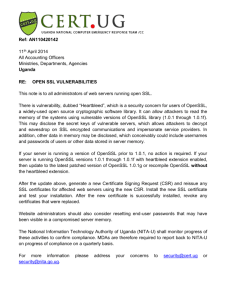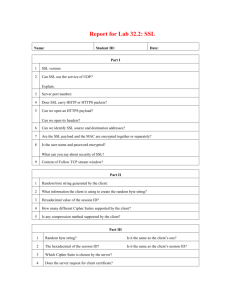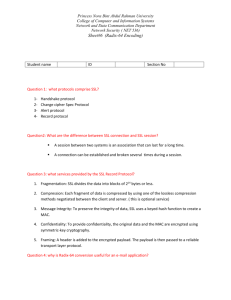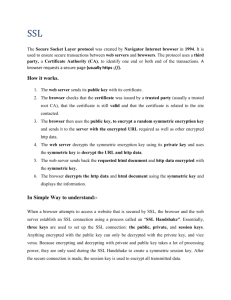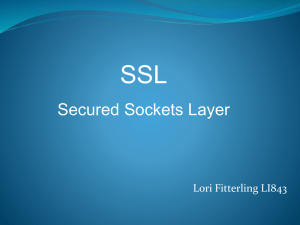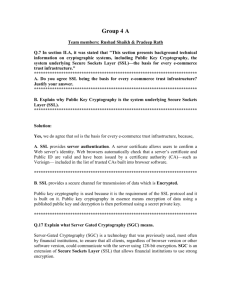2. Secure Web Switch
advertisement
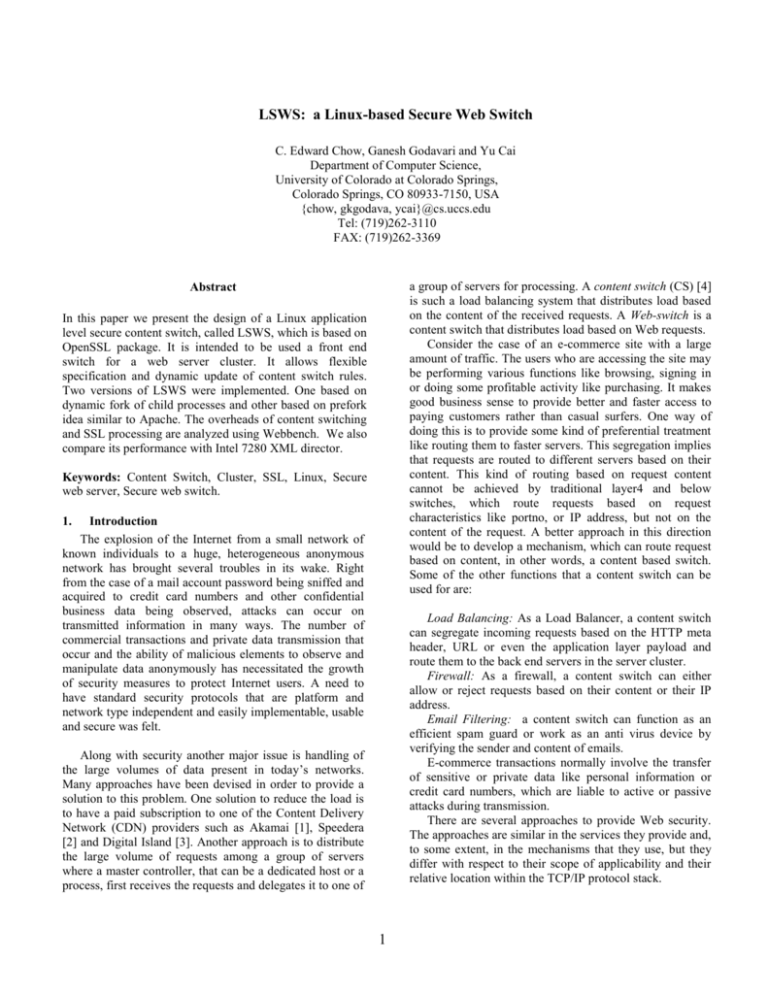
LSWS: a Linux-based Secure Web Switch
C. Edward Chow, Ganesh Godavari and Yu Cai
Department of Computer Science,
University of Colorado at Colorado Springs,
Colorado Springs, CO 80933-7150, USA
{chow, gkgodava, ycai}@cs.uccs.edu
Tel: (719)262-3110
FAX: (719)262-3369
a group of servers for processing. A content switch (CS) [4]
is such a load balancing system that distributes load based
on the content of the received requests. A Web-switch is a
content switch that distributes load based on Web requests.
Consider the case of an e-commerce site with a large
amount of traffic. The users who are accessing the site may
be performing various functions like browsing, signing in
or doing some profitable activity like purchasing. It makes
good business sense to provide better and faster access to
paying customers rather than casual surfers. One way of
doing this is to provide some kind of preferential treatment
like routing them to faster servers. This segregation implies
that requests are routed to different servers based on their
content. This kind of routing based on request content
cannot be achieved by traditional layer4 and below
switches, which route requests based on request
characteristics like portno, or IP address, but not on the
content of the request. A better approach in this direction
would be to develop a mechanism, which can route request
based on content, in other words, a content based switch.
Some of the other functions that a content switch can be
used for are:
Abstract
In this paper we present the design of a Linux application
level secure content switch, called LSWS, which is based on
OpenSSL package. It is intended to be used a front end
switch for a web server cluster. It allows flexible
specification and dynamic update of content switch rules.
Two versions of LSWS were implemented. One based on
dynamic fork of child processes and other based on prefork
idea similar to Apache. The overheads of content switching
and SSL processing are analyzed using Webbench. We also
compare its performance with Intel 7280 XML director.
Keywords: Content Switch, Cluster, SSL, Linux, Secure
web server, Secure web switch.
1.
Introduction
The explosion of the Internet from a small network of
known individuals to a huge, heterogeneous anonymous
network has brought several troubles in its wake. Right
from the case of a mail account password being sniffed and
acquired to credit card numbers and other confidential
business data being observed, attacks can occur on
transmitted information in many ways. The number of
commercial transactions and private data transmission that
occur and the ability of malicious elements to observe and
manipulate data anonymously has necessitated the growth
of security measures to protect Internet users. A need to
have standard security protocols that are platform and
network type independent and easily implementable, usable
and secure was felt.
Load Balancing: As a Load Balancer, a content switch
can segregate incoming requests based on the HTTP meta
header, URL or even the application layer payload and
route them to the back end servers in the server cluster.
Firewall: As a firewall, a content switch can either
allow or reject requests based on their content or their IP
address.
Email Filtering: a content switch can function as an
efficient spam guard or work as an anti virus device by
verifying the sender and content of emails.
E-commerce transactions normally involve the transfer
of sensitive or private data like personal information or
credit card numbers, which are liable to active or passive
attacks during transmission.
There are several approaches to provide Web security.
The approaches are similar in the services they provide and,
to some extent, in the mechanisms that they use, but they
differ with respect to their scope of applicability and their
relative location within the TCP/IP protocol stack.
Along with security another major issue is handling of
the large volumes of data present in today’s networks.
Many approaches have been devised in order to provide a
solution to this problem. One solution to reduce the load is
to have a paid subscription to one of the Content Delivery
Network (CDN) providers such as Akamai [1], Speedera
[2] and Digital Island [3]. Another approach is to distribute
the large volume of requests among a group of servers
where a master controller, that can be a dedicated host or a
process, first receives the requests and delegates it to one of
1
One way to provide Web security is to use IP Security
or IPSEC [5] as it is generally called. The advantage of
using IPSec is that it is transparent to end users and
applications and provides a general-purpose solution.
Further, IPSec includes a filtering capability so that only
selected traffic need incur the overhead of IPSec
processing.
Another relatively general-purpose solution is to
implement security just above TCP. The foremost example
of this approach is the Secure Sockets Layer (SSL) [6] and
the follow-on Internet standard of SSL known as Transport
Layer Security (TLS) [7]. At this level, there are two
implementation choices. For full generality, SSL (or TLS)
could be provided as part of the underlying protocol suite
and therefore be transparent to applications. Alternatively,
SSL can be embedded in specific packages. For example,
Netscape [8] and Microsoft Explorer [9] browsers come
equipped with SSL, and most Web servers have
implemented the protocol.
SSL operates independently and transparently of other
protocols so it will work with any application-layer and any
transport-layer protocol. This allows clients and servers to
establish secure SSL connections.
An application layer protocol sends unencrypted data to
the session layer. TLS/SSL encrypts the data and hands it
down to the lower layers. When its peer receives the data at
the other end, it passes it up through the layers to the
session layer where TLS/SSL decrypts it and hands it to the
application layer. Since the client and the server have gone
through the key negotiation handshake, the symmetric key
used by SSL is the same at both ends.
2.1. SSL Transactions
To illustrate how SSL works, assume a user wants to
make a purchase over the Internet and needs to send a
credit card number to a secure Web site [15].
There are several commercial content switches. The
Alteon iSD-SSL accelerator[10] works with an Alteon Web
switch to intelligently speed secure
e-Commerce
transactions by offloading Secure Sockets Layer (SSL)
processing from local servers without imposing delays on
other traffic in the same data path. F5 has long been a
leader in the Internet Traffic Management space. It has an
advanced web switching logic (F5 Networks Big-IP
Controller 3.1[11]). Big-IP combines a strong, traditional
load-balancing feature set with SSL acceleration ability. It
extracts HTTP header information from the request to make
traffic management decisions. Foundry (Foundry
Networks ServerIronXL with Internet IronWare 7.0
[12]) equips its ServerIronXL with a strong Layer 2 and
Layer 3 switching and Layer 5/7 load-balancing based on
cookies and SSL session IDs. Intel provides CEA7110 [13]
SSL Accelerator and CEA7280 [14] XML Director which
is very close to features that our LSWS provide. It is
capable to perform routing based on url and xml tag values.
2.
Figure 2.2 illustrates the steps taken during an SSL
negotiation
Initially, the request for an SSL session comes from the
browser to the Web server.
The Web server then sends the browser its digital
certificate. The certificate contains information about the
server, including the server’s public key.
Once the browser has the server’s certificate, the
browser verifies that certificate is valid and that the CA is
listed in the client’s list of trusted CA’s. The browser also
checks the certificates expiration date and the Web server
domain name.
Once a browser has determined that the server
certificate is valid, the browser then generates a 48-byte
master secret key. This master secret key is encrypted using
server’s public key, and is then sent to the Web server.
Upon receiving the master secret from the browser, the
Web server then decrypts this master secret key using the
server’s private key.
As both the browser and the Web server have the same
master secret key, they use this master secret to create keys
for the encryption and MAC algorithms used in the bulkdata process of SSL. Since both participants use the same
master key, they now have the same encryption and MAC
keys.
As both the browser and Web serve have the same
encryption and MAC keys, they use the SSL encryption and
authentication algorithms to create an encrypted tunnel.
Through this encrypted tunnel, they can now pass data
securely through the Internet.
Secure Web Switch
The SSL protocol is a security protocol that sits on top
of TCP at the transport layer. In the OSI model, application
layer protocols such as HTTP or IMAP handle user
application tasks such as displaying Web pages or running
email servers. Session layer protocols establish and
maintain communications channels. Transport-layer
protocols such as TCP and UDP, handle the flow of data
between two hosts. Network layer protocols such as IP and
ICMP provide hop-by-hop handling of data packets across
the network.
2
Though the authentication and encryption process may
seem rather involved, it happens in less than a second.
Generally, the user does not even know it is taking place.
However, the user will be able to tell when the secure
tunnel has been established since most SSL-enabled Web
browsers will display a small closed lock at the bottom or
top of their screen when the connection is secure. Users can
also identify secure Web sites by looking at the Web site
address; a secure Web site’s address will begin with https://
rather than the usual http://.
Figure 2.3 Architecture of secure content switch
The following steps describe the process of handling
secure requests using the secure content switch.
The web browser makes a request to the secure content
switch.
The dispatcher module in the secure content switch
forwards the request to the secure content switch child
module. In the dynamic forking version of secure content
switch the dispatcher module forks a child process. In the
preforking version of secure content switch the dispatcher
module forwards the request to a free child.
The secure content switch child module performs the
handshake with the client and reads in the request.
The secure content switch child module then sends the
request to the Rule module, which performs rule matching
and returns the name of the server by which the request can
be served.
The real server connects to the web browser through the
secure content switch child module (not shown in the
picture).
2.2. OpenSSL: The Open Source toolkit for SSL/TLS
[16]
OpenSSL is based on the excellent SSLeay [17] library
developed by Eric A. Young and Tim J. Hudson. Open
Source toolkit implements the Secure Socket Layer (SSL
v2/v3) and Transport Layer Security (TLS v1) protocols as
well as a full-strength general-purpose cryptography
library.
OpenSSL contains two important libraries:
OpenSSL SSL library implements the Secure Sockets
Layer (SSL v2/v3) and Transport Layer Security (TLS v1)
protocols.
OpenSSL CRYPTO library implements a wide range of
cryptographic algorithms used in various Internet standards.
The services provided by this library are used by the
OpenSSL implementations of SSL, TLS and they have also
been used to implement SSH [18], OpenPGP [19], and
other cryptographic standards.
2.3.1. Secure Content Switch Child Module.
The child module performs the SSL handshake with the
client. This step involves establishing ciphers to use and
providing certificate to the client for server-authentication.
As part of the SSL Handshake request, the client may
provide a current or previously created SessionID to reuse
for the current connection. The Secure content switch
manages the SessionID and this will be used as appropriate
during the SSL Handshake. The child module receives the
request for data and decrypts the data according to the
negotiated SSL handshake. When the Secure content switch
process determines it has fully received an HTTP request, it
sends header information to the Rule Matching Module,
which determines which Real Server can serve the request.
The child module then establishes a connection with the
Real Server and forwards the request in plain HTTP.
In addition, the OPENSSL program is a command line
tool for using the various cryptography functions of
OpenSSL's crypto library from the shell. It can be used for
Creation of RSA [20], DH [21] and DSA [22]
key parameters.
Creation of X.509 certificates [23] and
Certificate Revocation List (CRL).
Calculation of Message Digests
Encryption and Decryption with Ciphers.
SSL/TLS Client and Server Tests.
Handling of S/MIME signed or encrypted mail.
3.
Performance Results
This section presents the performance results of
the Linux application secure content switch. Fig shown
below shows a block diagram of Secure Linux Application
level content switch.
2.3. Software architecture of secure content switch
The following figure 2.3 shows the architecture of the
current design of secure content switch.
3
The tests were performed using Web bench [24] and the
negotiated cipher suite for these tests are
Negotiated Cipher Suite
DES-CBC3-SHA
SSLv3 Kx=RSA
Enc=3DES(168) Mac=SHA1
Au=RSA
Dynamic Forking vs. Pre-forking secure content switch
Figure 3.2 and Table 3.2 shows the results
The performance of the Dynamic forking secure content
switch is better than Pre-forked secure content switch. I
found out that after a while the children are created and
killed immediately with out serving multiple requests. The
Pre-forked server is designed to see that child SSL
Processes are created ahead of time and kill them if their
number exceeds a certain threshold. The reason could be
that more child processes are free which implies number of
requests sent by the web-bench is irregular, there by
affecting the overall performance of the pre-forked secure
content switch.
Figure 3.1 showing the block diagram of the secure
content switch test bed
Table 3.1 shows the hardware and
configuration of machines used in the test-bed.
software
Machine Spec
IP Address
O/S
Web
Server
a)
128.198.192.184
Redhat 7.2
(2.4.9-21)
Apache
1.3.22
128.198.60.195
Redhat 7.2
(2.4.9-21)
Apache
1.3.22
128.198.60.23
128.198.60.202
128.198.60.204
a) Windows NT,
4.0
b), c) Windows2000,
Advanced
Server
N/A
128.198.60.188
128.198.60.183
128.198.60.182
128.198.60.196
128.198.60.197
128.198.60.208
Redhat 7.1
(2.4.3-12)
Apache
1.3.19
CALVIN.uccs.edu
DELL Dimension4100, 933 MHz,
512MB
b) oblib.uccs.edu
HP Vectra VL
512 MHz, 512MB
Figure 3.3 shows the impact of rules on the performance
of the linux secure content switch. There is no major
impact on the performance of our secure content switch
with respect to the number of rules. This clearly shows us
SSL processing is the major hurdle.
Cluster with secure content switch vs. standalone
Apache web server
The performance of a dynamic forking secure content
switch was pretty good when compared to a standalone
apache server. Taking into fact that amount of computation
overhead involved with extracting the HTTP headers and
performing a rule matching on the HTTP header data, and
routing the request to one of the Real Servers
(Content switch)
a) dilbert.uccs.edu
b) wait.uccs.edu
c) wind.uccs.edu
(Client)
a) eca.uccs.edu
b) frodo.uccs.edu
c) bilbo.uccs.edu
d) odorf.uccs.edu
e) walrus.uccs.edu
f) wallace.uccs.edu
4.
Performance Comparison with Intel SSL
accelerator and XML director.
Intel 7280 XML Director is configured as content switcher
(named lizzie), and it directs XML content to eca and frodo
respectively, according to the pre-defined rules.
We implement a software XML content switch, installed on
calvin.uccs.edu. It directs XML content to eca and frodo
respectively, according to the pre-defined rules.
HP Kayak
Machines, 233
MHz, 96MB RAM
(Real Server)
Table 3.1 Configuration of machines used in
performance tests
4
Problem encountered
When the size of XML document (with SSL) increases
(above 500k), Intel 7280 gets very picky on the format of
XML document. we always get “403 POSTed data was not
welformed” error. But actually the format of that XML
document are perfectly OK. Because of this, the result
curve named “Intel 7280+SSL” on the testing result chart
(Fig 4.2) is incomplete.
5.
Conclusion and Future Work
We have developed a content switch that support SSL.
The software package currently uses OpenSSL version 0.6.
The features of our content switch include session id reuse
and high encryption strength. We have tested it on a cluster
test-bed using the industry standard benchmarking software
and found its performance to be satisfactory. Based on the
test results we have found that there is not much
improvement in terms of processor speed,
Figure 4.1 Network topology for Intel 7280 unit
We run a perl script on testing machine. It sends XML
content to lizzie (Intel 7280 XML Content Switch) and
calvin (Software XML Content Switch).
By repeating the same XML requests 30 times, we get
the average XML file content switch processing speed.
We then increase the XML length, by adding more content
in the XML file, and see if the processing time increases or
not. We do the test on both plain text request scenario and
SSL request scenario.
One of the improvements that are possible is
reducing the bottleneck of SSL encryption / decryption.
SSL transactions are computation intensive and hence
become a drain on web server resources. In cases of web
servers handling a large amount of traffic, the problem can
become more significant. One way to alleviate the problem
is to apply parallel processing techniques. But as one
ponders about a solution for this problem, we need to think
about how all the web servers are going to know about the
TLS/SSL session information that was negotiated by
another server. There is a message in the openssl group
posted by Lutz Jaenicke that talks of a future version
OpenSSL 0.9.7 (not yet released) that has a new function
(server side) to explicitly choose the session IDs generated
(rather than random values as of now). Therefore it will be
possible to include a "server ID" into the session ID so that
load balancing will become easier. Once the abovementioned version is released, a solution might be in sight.
Figure 4.2 Test result on XML content switch
processing time on Intel 7280 unit and Software Content
Switch
Another performance improvement can be the caching
of web pages. This aspect must be handled sensibly as most
of the web documents that use SSL are dynamic in nature.
It seems that Intel 7280 unit and Software Content
Switch, both process XML data pretty fast. Amazingly
enough, Intel 7280 is only a little bit faster than LSWS, and
if the XML document size is not large enough, there are
very little difference on performance.
One of the ways to overcome the problem of
maintaining state across multiple web processes in dealing
with TLS/SSL transactions is to make the connections
“sticky”. The problem with this design is that the IP
addresses are constantly shifting for users coming into a
site from Internet service providers that use proxy servers.
So users must have a “sticky” connection to the SSL server
that is independent of their IP address. This can be achieved
by having a cookie which identifies which Real Server has
serviced the user previously.
Another suggestion for improving the current content
switch performance is to have a persistent HTTP
connection between the Content switch and the Real
For the XML data with SSL encryption, Intel 7280
process SSL request by itself, and then redirect plain text
request to eca/frodo. On the other hand, the Software
Content Switch process SSL request on Calvin by software,
then redirect plain text request to eca/frodo too. We expect
Intel 7280 should run a lot faster than the Software Content
Switch. But we didn’t observe that in our test.
5
Servers, which can be used by all the processes, for all the
requests.
http://www.foundrynetworks.com/techdocs/SI/index.ht
ml
[13] Intel NetStructure 7180 e-commerce Director
http://www.intel.com/support/netstructure/commerce/in
dex.htm
Each of these solutions comes with its own combination
of cost, performance, and flexibility of scale—proving once
again that, when it comes to Web site architecture, one size
never fits all.
6.
[14] Intel NetStructure 7280 XML Director
http://www.intel.com/support/netstructure/director/inde
x.htm
[15]white paper by cacheflow
http://www.cacheflow.com/files/whitepapers/wp_ssl_pr
imer.pdf
[16] OpenSSL: The Open Source toolkit for SSL/TLS
(http://www.openssl.org)
[17] The SSLeay package is copyright Eric Young and
is available free for commercial and non-commercial
use.
[18] ssh prtocol http://www.ietf.org/html.charters/secshcharter.html
[19] OpenPGP the most widely used email encryption
standard in the world. http://www.openpgp.org/
[20] RSA algorithm invented in 1978 by Ron Rivest,
Adi Shamir, and Leonard Adleman.
http://www.rsasecurity.com/
[21] The Diffie-Hellman Key Agreement,
http://www.hamiltonlabs.com/links.htm
[22] NIST, FIPS PUB 186, "Digital Signature
Standard", May 1994.
[23] public-key infrastructure (X.509)
http://www.ietf.org/html.charters/pkix-charter.html
[24] web bench is the testing tool provided by eTesting
Labs Inc. http://webbench.com/
References
[1]Akamai technologies http://www.akamai.com/
[2]Speedera http://www.speedera.com/flash_index.html
[3] Digitalisland http://www.digitalisland.com/
[4] George Apostolopoulos, David Aubespin, Vinod
Peris, Prashant Pradhan, Debanjan Saha, “ Design,
Implementation and Performance of a Content-Based
Switch”, Proc. Infocom2000, Tel Aviv, March 26 - 30,
2000, http://www.ieee-infocom.org/2000/papers/440.ps
[5] IP Security Protocol,
http://www.ietf.org/html.charters/ipsec-charter.html
[6] SSLv3 Internet Draft (obsolete).
ftp://ftp.ietf.org/internet-drafts/draft-ietf-tls-sslversion3-00.txt.
[7] RFC2246 - "The TLS Protocol Version 1.0"
ftp://ftp.isi.edu/in-notes/rfc2246.txt
[8] Netscape web browser http://www.netscape.com/
[9] Microsoft Internet Explorer web browser of
Microsoft Technologies http://www.microsoft.com
[10] Web switch product of nortel networks
http://www.nortelnetworks.com/products/01/alteon/isds
sl/index.html
[11] web switch product of F5networks
http://www.f5networks.com/
[12] Foundry ServIron Installation and Configuration
Guide, May 2000.
Request
Request
Per Second
Per Second
Prefork
Request
Per Request
Request
PerPrefork
NonSecure Second DynamicPer
SecondSecond DynamicSecure
Request
content
NonSecure
Apache
Secure
contentcontent
Per Second
Client
switch
content switch
NonSSL
switch
switch
Apache SSL
1_client
148.046
82.588
244.404
26.992
23.042
37.450
4_client
146.542
84.283
241.296
26.100
20.858
36.958
8_client
128.688
82.642
234.867
26.113
21.704
37.479
12_client
145.521
83.567
230.183
26.279
20.246
37.279
16_client
148.100
82.017
236.350
26.425
21.604
37.396
20_client
147.946
83.433
241.475
26.333
19.462
36.962
24_client
135.046
82.642
237.050
26.358
21.004
37.833
28_client
148.058
83.158
234.037
26.421
20.279
38.150
32_client
126.621
82.767
241.037
26.275
20.358
38.346
36_client
123.542
81.933
242.046
25.783
20.275
38.375
6
40_client
148.121
81.575
239.567
25.625
21.188
37.892
44_client
129.762
83.112
232.988
26.033
20.163
37.804
48_client
148.113
83.421
243.688
26.304
20.404
37.571
52_client
147.850
81.975
244.037
26.063
21.446
37.400
56_client
106.900
82.254
243.258
26.350
17.363
37.063
60_client
128.879
83.254
243.554
26.212
15.800
36.188
Table 3.2 showing the request/sec of different types of secure content switch
Overall WebBench Requests/Second
Requests / Second
300.000
250.000
Request Per Second Prefork
NonSSLProxy
200.000
Request Per Second Dynamic
NonSSLProxy
150.000
100.000
Request Per Second Apache
NonSSL
50.000
Request Per Second Dynamic
SSLProxy
60_client
56_client
52_client
48_client
44_client
40_client
36_client
32_client
28_client
24_client
20_client
16_client
8_client
12_client
4_client
1_client
0.000
Request Per Second Prefork
SSLProxy
Request Per Second Apache
SSL
Clients
Figure 3.2. Content switching/SSL processing overhead and Performance differences between Prefork and
Dynamic fork.
Overall Im pact of Rules on Requests/Second
Requests/Second
30.000
SSL Requests Per Second
for 250 Rules
25.000
SSL Requests Per Second
for 300 Rules
20.000
15.000
SSL Requests Per Second
for 500 Rules
10.000
5.000
SSL Requests Per Second
for 1000 Rules
0.000
1_
cl
ie
nt
8_
cl
ie
nt
16
_c
li e
nt
24
_c
li e
nt
32
_c
li e
nt
40
_c
li e
nt
48
_c
li e
nt
56
_c
li e
nt
SSL Requests Per Second
for 2000 Rules
SSL Requests Per Second
for 5000 Rules
Clients
Figure 3.3. Impact of # of content switching rules over performance.
7


